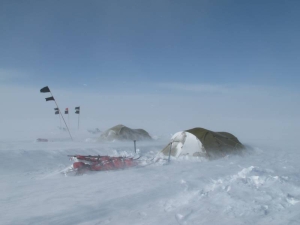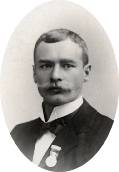StormThis was supposed to be the day we started on the last 500 km to the South Pole. But the weather put a stop to that. During the night the wind picked up so much that it would have been foolhardy to set out on skis. The risk of frostbite was too great.
“How often has it not happened to me, that a day that one had expected nothing at all of – brought a great deal. – Gale from SE during the night and in the morning more drift and almost no visibility. Admittedly I had decided on a rest day for the doggies. But – in a little lull – we all agreed nonetheless to set off and try.”– Amundsen on this day 100 years ago (Read more …) 
Despite the fact that we’re taking it easy in our tents, the slightest movement of a tentmate is accompanied by audible heavy breathing. Amundsen also felt the elevation: “When I wanted to turn in my sleeping bag I had to do it in stages so as not to get out of breath. To get all the way around, I had to stop and take a few extra breaths. That comrades had the same problem was clear without any need to ask them. Hearing them was enough.” We recognise all this description. Because of the earth’s rotation the atmosphere is thinner at the poles than at the equator. Thinner atmosphere means lower pressure and less oxygen in polar regions than at lower latitudes. At any specific elevation above sea level, the amount of oxygen is unevenly distributed and varies depending the location on the globe. The consequences are clearly noticeable. For example, 3000 metres above sea level in Antarctica corresponds to 3550 metres in the Himalayas. If you climb the highest mountain in Antarctica, Mount Vinson (4892) that corresponds to just over 6000 metres elevation in the Himalayas. In the past few days we have climbed from sea level to about 3000 metres above sea level. The slopes have already taken a toll, but from now on we will be breathing only 62% of the oxygen we would have had at sea level. Position: S 85 39.473, W 169 36.203
Temperature: 27°C Wind: 12–16 m/s from the southeast Elevation: 2800 metres Distance traversed: 0 km Distance behind Amundsen: 108 km Total distance traversed: 812 km Distance remaining to the South Pole: 499 km
Did you know that Sverre Hassel declined to participate in a later expedition with Amundsen?
Sverre Helge Hassel (1876–1928) was born in Oslo. He went to sea at an early age and trained to the rank of first mate and captain. |
South Pole 1911–2011 is an informational outreach project run by the Norwegian Polar Institute
Contact person:


